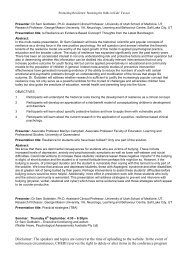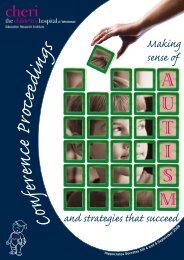conceptual framework of behaviour management - CHERI - The ...
conceptual framework of behaviour management - CHERI - The ...
conceptual framework of behaviour management - CHERI - The ...
Create successful ePaper yourself
Turn your PDF publications into a flip-book with our unique Google optimized e-Paper software.
Strategic Management <strong>of</strong> Studentswith Emotional, Behavioural andMental Illness in MainstreamSettingsThursday 3 rd September 2009Cheri Conference<strong>The</strong> Children's HospitalPresented byMr Ross BlackMs June Simpson
Key Objectives1. An understanding <strong>of</strong> Mental Health Issues for students in a MainstreamSchool Setting2. An understanding <strong>of</strong> a Conceptual Framework <strong>of</strong> Behaviour Management3. An understanding <strong>of</strong> a Collaborative Problem Solving Approach4. An understanding <strong>of</strong> the processes involved in developing:- Individual Management Plan- Individual Self Control Plan- Individual Self Management Plan- Individual Safety Plan
Rivendell ProgramsPaterson Program(Behavioural)Yaralla Program(<strong>The</strong>rapeutic)Lawson Program(<strong>The</strong>rapeutic)Sulman Program(Tutorial)Gna Ka LunWalker Unit(Campbelltown Hospital) (Concord Hospital)Outreach
HEALTH(Treatment Programs)COMMUNICATIONCOLLABORATIONEDUCATION(Educational & Vocational)FUNCTIONAL OUTCOMES
Collaborative Problem SolvingRecognises that:Students with <strong>behaviour</strong>al issues have specific learning difficulty in the areas <strong>of</strong>:• Executive Skills• Language Processing Skills• Emotional Regulation Skills• Cognitive Flexibility Skills• Social Skills
<strong>The</strong> importance <strong>of</strong>Strategic Languagein Managing Behaviour Difficultyeg. Warnings to Reminders
Using the BehaviourManagement System as aTeaching and Learning Tool
Behaviour Management SystemTeaching and Learning OpportunityCueWarning 1 Reminder 1Warning 2 Reminder 2Quiet AreaReflectionTime OutWorking It Out
FEATURES OF AN EFFECTIVE MANAGEMENT STRATEGY1. SIMPLE NOT COMPLEX – IMPLEMENTATION REASONABLE2. TEACHING AND LEARNING TOOL3. CONSISTENT4. CREATES A STRUCTURED ENVIRONMENT5. FOLLOWS A LOGICAL PROCEDURE USED BY ALL RELEVANT STAFF6. FLEXIBLE – TO MEET INDIVIDUAL STUDENTS NEEDS7. EVOLVING – CONTINUALLY DEVELOPING8. EVALUATED AT REGULAR INTERVALS9. SEEN TO BE FAIR AND NON-DISCRIMINATORY10. HAS APPROPRIATE WORDS AND PHRASES11. USES STRATEGIC LANGUAGE12. DEVELOPED COLLABORATIVELY WITH ALL STAKEHOLDERS13. CAN BE EXPLAINED TO PARENTS/CARERS14. HAS A PHILOSPHICAL UNDERPINNING15. COMMUNICABLE
<strong>The</strong> need forRUBBER BOUNDARIESelasticflexiblestudent friendlycontainingN.B. <strong>The</strong>se are still realistic. Not so elastic that thestudent can crash through.
PLAN A / PLAN B / PLAN CPlan A – Normal Management ExpectationPlan B – Behaviour Management PlanningTeaching and Learning ModelPlan C – Prioritizing / Flexible Management
Behaviour Management System FrameworkPrimary PlanBack Up PlanBehaviourManagementSystemIndividualManagement PlanStudent Self ControlPlanStudent SelfManagement PlanEmergency PlanIndividual SafetyManagement PlanCrisis CommunicationEvasionRestraintReasonable force
Behaviour Management SystemTeaching and Learning OpportunityCuesReminder 1Reminder 2ReflectionDET Procedures are followedfor extreme <strong>behaviour</strong>WORKING IT OUT
Teaching and Learning Models- Developing relevant thinking skills
A cognitive <strong>behaviour</strong>alapproach to managing<strong>behaviour</strong> through teachingand learning
<strong>The</strong> Stress ModelCommunication Model<strong>The</strong> Translation ModelNegative SpiralSnowballChoices/Made onSuccess or Negative LineBehaviour Management SystemSelf Control PlanSelf Management PlanReflection & Working It OutPositive Self TalkUnderstanding Stimulus Response
STRESS MODELPull backescalationCrisisManagement Plan(C.M.P.)de-escalationprovocationboredomfrustrationanxietyperceived unfairnesschange <strong>of</strong> routineaggressionPost-crisis depression
COMMUNICATION MODELWithdrawnPassiveAssertiveAggressiveAssaultiveIgnoringSarcasmClear CommunicationAbusiveHitDismissiveNot speakingBody languageFeigned –deafnessblindnessamnesiaProvokingSetting upTone <strong>of</strong> VoiceHonestCommunicationNegotiationPositiveGood choicesCooperationTone <strong>of</strong> VoiceIntimidationThreateningShoutingSwearingProvokingTone <strong>of</strong> VoiceKickPunchSpit
Translation ModelWITHDRAWN PASSIVE ASSERTIVEAGGRESSIVEASSAULTIVELost in TranslationInappropriateQualifierWITHDRAWNPASSIVE ASSERTIVE AGGRESSIVE ASSAULTIVEExample: Students with Specific Learning Difficulties in theCommunication Area.
NEGATIVE SPIRALOVER REACTIVEPROVOCATIVESHORTCIRCUITREACTIVE
SNOWBALL EFFECT
CHOICESSUCCESS LINEPOSITIVEOUTCOMES___________________________________NEGATIVE LINENEGATIVEOUTCOMES___________________________________
REFLECTION & WORKING IT OUTTHINK, DISCUSS, DECIDE
STIMULUS RESPONSE MODELP R P R P OR P ORNegativeConsequenceSeriousConsequenceP = PROVOCATIONR = REACTIONOR = OVER-REACTIONPOSITIVE STRATEGIES1. SELF CONTROL PLANS POSITIVEOUTCOMES2. USE POSITIVE GROUPSELF CONTROL PLANS
KEY FEATURES OF AN INDIVIDUAL MANAGEMENT PLAN1. Student’s presenting <strong>behaviour</strong>s are listed clearly and succinctly.2. Management strategies as agreed upon by staff are listed clearlyand are reviewed regularly.3. Useful language and phrases to be used in dealing with thestudent are included.4. Flexibility issues are spelt out for staff, e.g. situations wherestudent may be anxious.5. Positive reinforcement strategies are listed.6. Individual Safety Plans are developed as appropriate.<strong>The</strong> Individual Management Plan needs to be developed by,understood by, and communicated to, all staff. It needsto be reviewed regularly.
Individual Management PlanPRESENTING BEHAVIOURSPOSITIVE BEHAVIOURSUSEFUL LANGUAGE AND PHRASESMANAGEMENT STRATEGIESPOSITIVE REINFORCEMENT STRATEGIESFLEXIBILITY ISSUES
Student – Jon DoeIndividual Management PlanPresenting Behaviours• Physical pushing/touching other students –“playing” or “only joking”• Provoking others with quiet comments andglaring especially when teacher not looking• Can be physically and verbally aggressive tostudents and staff• Can damage property when angry• Can throw objects including furniture atothers• Intimidation <strong>behaviour</strong>s (showing power)eg: pretends to hit/kick other students withclose proximity to their body• Says sorry after inappropriate <strong>behaviour</strong> toavoid consequences• Can be verbally defensive wheninappropriate <strong>behaviour</strong>s are addressed• Pushing furniture
Student – Jon DoeIndividual Management PlanPositive Behaviours• Charismatic• Academically capable• Can be focused and on task• Responds to positives – verbal, merits andgestural reinforcements• Friendly• Helpful – likes to do tasks• Polite• Verbally able to describe feelings andtriggers – when calm• Enjoys sport• Can de-escalate• Can negotiate on task time frames when insettled mood
Student – Jon DoeIndividual Management PlanManagement Strategies• Allow Jon Doe to go for a walk if he feels heis getting angry• Cue Jon Doe that he may need to go for awalk if he is becoming unsettled• Deal with small issues• Use calm, quiet manner• Give him space• Explain label his <strong>behaviour</strong>s in a calmvoice• Choices with limits eg: with his academicprogram, free time activities
Student – Jon DoeIndividual Management PlanUseful Language and Phrases• Remember your self-control plan• Do you need to go for a walk• Personal space / intimidating
Student – Jon DoeIndividual Management PlanPositive Reinforcement Strategies• Use Merit Award System• Verbal Praise• Free time eg: computer, structured art and craft activities
Student – Jon DoeIndividual Management PlanFlexibility Issues• Be aware <strong>of</strong> his reactions – can escalate rapidly• Be aware <strong>of</strong> his perceived unfairness issues• Be aware that he is only 13 years old
Student – Jack StudentIndividual Management PlanPresenting Behaviours• Physically aggressive to peers• Physically aggressive to staff when alreadyescalated• Intimidates peers – verbal abuse, invadespersonal space• Rude and verbally abusive to staff – maytreat as servants• Attributes hostile intent to others• Reacts with hostility to perceived unfairness• Sense <strong>of</strong> superiority• Reacts angrily when confronted about hisown <strong>behaviour</strong>• Manipulative / provocative to peers• Sensitive to loud noise, tries to control others(teacher, students) in response• Rigid in his thinking – unresponsive toreasoning• Anxiety expressed in rigidity,argumentative <strong>behaviour</strong>, body language• Vulnerable to bullying and teasing• Once escalated, unable to use any prearrangedstrategies• Cannot be distracted when anxious,escalated• Strong interest in weapons• Intrusive comments• Racist comments and <strong>behaviour</strong>• Difficulty reading social cues, others’emotions• Poor organisational skills
Student – Jack StudentIndividual Management PlanPositive Behaviours• Intelligent and articulate• Can be engaging and likable• Academically capable• Sense <strong>of</strong> honour where money isconcerned• Motivated to complete Year 6 at his school• Cooperative when calm
Student – Jack StudentIndividual Management PlanManagement Strategies• Use a quiet, calm detached approach• Do not confront him when he is escalating• Do not try to reason with him when he isupset/angry/anxious – reduce verbalcommunication• Remain aware that anxiety may underliedifficult <strong>behaviour</strong> – focus on loweringanxiety• Allow him to phone his mother/family onrequest when anxious/escalating• Allow him to phone his mother/family onrequest when anxious/escalating• Never block access to a door when he isupset or uncooperative• Pull out <strong>of</strong> power struggles/arguments withhim to avoid escalation• Offer choices where possible when givinginstructions (“Do you want to start on thispage or this one?”)• Be aware that he is affected by loud noise– adjust environment where possible, lethim use ear plugs• Negotiate with him to choose a quieterarea <strong>of</strong> the playground during breaks• DROP NORMAL EXPECTATIONS WHENNECESSARY (Plan C) eg let him read abook rather than become frustrated withthe normal lesson
Student – Jack StudentIndividual Management PlanUseful Language and Phrases• “We’re stopping there Jack” (when he isbecoming argumentative)• “We want to keep you safe, Jack”• “Do you want to start on this page/task orthis one?”
Student – Jack studentIndividual Management PlanPositive Reinforcement Strategies• Verbal praise as appropriate (low Key)• Give responsibilities he values eg. Flag raising
Student – Jack StudentIndividual Management PlanFlexibility Issues• Use Plan C when necessary ie prioritise for safety and calm <strong>behaviour</strong>• Be aware that the presence <strong>of</strong> food may have a calming effect eg having a bowl <strong>of</strong> C.C.s on thetable during discussions/negotiations can help him to calm down
Student – Tom CaseIndividual Management PlanPresenting Behaviours• Cutting self (in and out <strong>of</strong> school)• Harassment <strong>of</strong> students by messaging (letter<strong>of</strong> caution from Principal)• Targeting Principal (vexatious threats)• Exhibiting cuts, blood stained clothes topeers• Suspected <strong>of</strong> texting and messaging topeers threats to self harm, suicide and hurt/ kill others• Manipulation / emotional blackmail <strong>of</strong> otherstudents• Manipulation <strong>of</strong> adults to disempower them• Playing adults <strong>of</strong>f against each other(parents / school)
Student – Tom caseIndividual Management PlanPositive Behaviours• Accepting <strong>of</strong> Year Advisor as mentor • Appropriate classroom <strong>behaviour</strong>
Student – tom caseIndividual Management PlanManagement Strategies• Agreement to behave in a safe way writtenand signed• Suspension if agreement not adhered to: toshort circuit pattern <strong>of</strong> <strong>behaviour</strong> and providea therapeutic break• Morning appointment with Year Advisor tocontinue• Monitor well being <strong>of</strong> other students
Student – tom caseIndividual Management PlanUseful Language and Phrase• Use low key, detached approach• Avoid sympathetic expressions <strong>of</strong> concern
Student – tom caseIndividual Management PlanPositive Reinforcement Strategies• Verbal praise as appropriate in classroom
Student – tom caseIndividual Management PlanFlexibility Issues• Special provision if required for assessment tasks
Student Self Control PlanName:200____Term____ Week ____----Possible Triggers--Features – What does this look and feel like?-----Strategies or Ideas to Manage the Situation
Student Self Control PlanName:Jon DoePossible Triggers(Perceived) Unfairness – by staff or studentsEXAMPLESIf someone hits me then I hit them, I would be the one in troubleIf someone gets longer free timeIf someone continually makes annoying soundsNeed to get revengeTalking – classroom noiseTime-Out – Having to sit and think about what I’ve doneDetention – usually end up suspended because I can not handle itNot wanting to do things
Student Self Control PlanName:Jon DoeWhat does this look like?SwearPhysical response / punching – but only if really angryProvocative – laugh if they are in trouble, glare, quiet comments
Student Self Control PlanName:Jon DoeIndications / FeelingsGet angryPrefer to stand than sitRestless
Student Self Control PlanName:Jon DoeStrategies to manage betterGet out <strong>of</strong> the situation – go for a walkSlow breathingIgnoreDiscuss with teacher, using assertive communicationRemember goalsPlan for a successful day
Individual Safety PlanName:200____Term____ Week ____Trigger(s):------Stress CycleFeatures – What could the crisis look like?Signs that he/she is moving up the stress cycle:------------Management Strategies
Individual Safety PlanName:Jon DoeTriggersJON DOE HAS BEEN KNOWN TO ESCALATE VERY QUICKLYPerceived unfairness eg having less “free time” than others; feeling he is being singledout to receive consequences if he believes others who were involved are not receivingconsequencesLosing his “free time” ie having to participate in WIO or discussion with staff in his freetime or lunch timeFeeling rejectedSelf frustration – not being able to achieve to a level he wants eg not being able tocompete at a high level in sport or computer gameFeeling others are not playing fairlyIntrusion into personal space including personal propertyRetribution – will “get back” at someone no matter how long it takesHe perceives what we say negatively or directly linked to consequences
Individual Safety PlanName: Jon DoeFeatures – What could the crisis look like?Signs that he is moving up the stress cycleFidgeting – twisting / tapping jewelleryRestless – prefers to pace than sit downLittle if any eye contact with staffDark looks – eyebrow raised, glaringRapid breathingClenched fist, punching the air, walls or treesImpaired listeningSwearingSlamming or pushing books pens and furnitureSetting up for rejection / seeking staff to collude to confirm his own negative self-beliefs.CRISIS (Has been known to)Throw furniture across room or at students or staffPhysically assault studentsDamage property eg: smash windows, damage furnitureDamage to himself – eg: punching wall
Individual Safety PlanName:Jon DoeManagement StrategiesUse calm tone <strong>of</strong> voice and body languageAllow large personal spaceAllow, and do not comment on, his choice <strong>of</strong> calming down strategies eg: removing himselffrom the situation and going to computerDO NOT use BMS, limit verbal interactionWhen setting up for rejection, useful comment is “We can talk about that later”, then moveawayAdvise Ross, Executive staff or Classroom TeacherIf necessary, implement Rivendell Safety Plan
Individual Safety PlanName: Jack StudentTriggers•Triggers not always evident or consistent•Internal anxiety a factor•Being teased or bullied•Frustration with school work•Being asked to participate in a lesson against his personal beliefs eg AboriginalEducation•Noise, perceived disruptive <strong>behaviour</strong> by other students, perceived teacher“incompetence”
Individual Safety PlanName: Jack studentFeatures – What could the crisis look like?Signs that he is moving up the stress cycle•Speaks in a very curt, precise way•Makes complaints <strong>of</strong> injury/illness (“I can’t walk up the stairs, I’ve hurt my leg” etc)•Intentional clumsiness•Overly reactive to sound – not necessarily loud•Body more rigid, tilts head to one side•Speaks through clenched teeth•Becomes argumentative•May become red in the face•May become teary•When crisis occurs – may rampage around the school, be aggressive to staff andstudents, lock self in a room- may demand to phone mother- will escalate further if spoken to at length, or told <strong>of</strong> consequences eg suspension
Management StrategiesIndividual Safety PlanName: Jack student•Lock classrooms down if he is on a “rampage”•Remove other students from the classroom is escalation occurs there•Do not stand between him and the door•Reduce verbal communication to a minimum – do not spell out consequences at thisstage•Use short, calming comments (“It’s ok Jack”, “We want you safe”)•Give options in a crisis or when escalating: “I’ll give you five minutes to calm down/openthe door/come out/go with Mum …….”•Ensure that essential contact phone numbers are readily available (parent, police ifsituation warrants) for emergency use.
Student Self Management PlanName:200____Term____ Week ____Possible TriggersFeatures – What does this look and feel like?Strategies or Ideas to Manage the Situation
SELF MANAGEMENT PlanName: William pupilPossible TriggersPerception that he is being insulted or put downMisunderstanding instructionsFamily issuesSeeking acceptance and attention from peers
SELF MANAGEMENT PlanName: William pupilFeatures – What does this look and feel like?Verbal responses – saying silly things to peers or staffOff taskNot letting others talkNot listeningClose physical proximity / touching others
SELF MANAGEMENT PlanName: William pupilStrategies or Ideas to Manage the SituationUsing a timetableClarifying classroom expectations eg: how much work needs to be completedThink “Is this the best choice for me?”Deep breathingListening to calming musicReading or drawing
GNA-KA-LUN: EDUCATIONAL SERVICES FLOWCHARTTRANSITION TO SCHOOL PLANNINGOUTREACH TEACHER ADVISED RELIKELY DISCHARGE DATE ONADMISSIONCase CoordinatorClinical TeamNO CONSENT:GNA contactsPrincipal Rivendellto discussCONSENT OBTAINED ON ADMISSIONFOR EXCHANGE OF INFORMATIONWITH SCHOOLS, DET PERSONNELCase CoordinatorClinical TeamDET PEO (OR NOMINEE) IN RELEVANTREGION ADVISED AS TO STUDENT’SPROPOSED DATE OF RETURNOutreach TeacherDGOPEO (OR NOMINEE) LIASES WITH CASECOORDINATOR, OUTREACH TEACHER,DGO RE INFORMATION RELEVANT TOSTUDENT’S SCHOOLPLACEMENT/SPECIAL NEEDS, RISKMANAGEMENT ISSUES ETCPeoOutreach TeacherDGO CaseCoordinator
GNA-KA-LUN: EDUCATIONAL SERVICES FLOWCHARTTRANSITION TO SCHOOL PLANNING (con’t)PEO (OR NOMINEE) LIASES WITH CASECOORDINATOR, OUTREACH TEACHER,DGO RE INFORMATION RELEVANT TOSTUDENT’S SCHOOLPLACEMENT/SPECIAL NEEDS, RISKMANAGEMENT ISSUES ETCPEOPEO (OR NOMINEE) COORDINATESRESOURCES WITHIN REGION,ORGANISES CASE CONFERENCE IFAPPROPRIATE eg WITH DADHC, CAMHS,DET PERSONNELNOTE: For ongoing Risk Assessment / Mental StateMonitoring local CAMHS must be involvedPEODECISION RE APPROPRIATESCHOOL/CLASS PLACEMENT, FUNDING& SUPPORT NEEDS; LIAISON WITHPARENTS/CARERSPEORegionalPersonnelONGOING MANAGEMENT THE RESPONSIBILITY OF LOCALAGENCIES & DET
INDIVIDUAL TRANSITION PLANName: Year:Gna Ka Lun Program: Class Teacher:Admission Date: Discharge Date:ACADEMIC GOALS STRATEGIES PERSONS/AGENCIESINVOLVEDOBSERVATIONS
INDIVIDUAL TRANSITION PLANName: Jan Doe Year: 9Gna Ka Lun Program Class Teacher:Admission Date: Discharge Date:ACADEMIC GOALS STRATEGIES PERSONS/AGENCIES INVOLVEDOBSERVATIONSTo re engage with amainstream schoolsetting•To contact High School’sSchool counsellor•Re: notification admissionto Gna Ka Lun•To contact the RegionalPEO for discharge fromGna Ka Lun, her return tohome and school.•<strong>The</strong> development <strong>of</strong> anIndividual ManagementPlan to support while sheis attending High School•Additionalsupport/considerations forJan DoePsychiatristGna Ka LunOutreachTeacherGna Ka LunRegionalPEOSEO2DGOSchoolCounsellorJan is a quiet student,who has been attendingthe GKL Learning Centreon a regular basis. Shehas a strong desire toreturn to her homeschool.Jan has difficulties inconcentrating on setactivities/tasks for longperiods <strong>of</strong> time and incompleting activitiesquickly. She also hasproblems in taking onboard and rememberingnew information/skills.
INDIVIDUAL TRANSITION PLAN (con’t)Name: Jan Doe Year:Gna Ka Lun Program Class Teacher:Admission Date: Discharge Date:ACADEMIC GOALS STRATEGIES PERSONS/AGENCIES INVOLVEDOBSERVATIONSRe gradual return toschool eg 2 x half days forthe first two weeks, thenreview her progress.•To return on days that thecounsellor is available tosupport her.•An alternative supportperson, if schoolcounsellor is not available.•Reduced work load forassessment tasks.CommunityMentalHealthCaseManagerJan has difficulty withorganizational skills egmisplacing books.Jan is a very polite youngperson, who is gainingconfidence in asking forassistance with her work.









